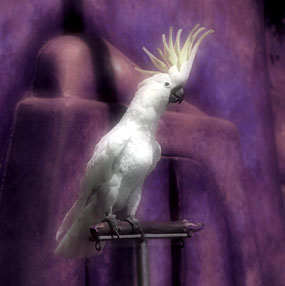
Rule of thumb: buy the best cage you can afford.
Some cages are sold at unbelievably low prices, but if you look at those “bargains” closely, you’ll see that these are just too small or are constructed from weak materials like plastic or thin metal.
Your cockatoo will be very unhappy in it. It’s a big bird that needs a lot of space.
Besides, you may realize that after you’ve put in the feeding dishes and an extra swing, you’ll barely be able to squeeze in your pet. But what about the perches, the toys, the mineral block, and the fact that a cockatoo will need enough wing room to hop, stretch, and play?
Also look at the material. It has to be able to stand up to the cockatoo’s powerful beak. Your best bet is a cage made from stainless steel: it’s durable, easy to clean, and won’t pose any risk of paint peeling off. Iron is also a strong material, but it can rust without any protective finish. Make sure it does not contain any lead or zinc.
Avoid acrylic cages, which may be appropriate for smaller birds, but the cockatoo will scratch it within weeks. Acrylic also tends to become a breeding ground for bacteria unless you have a fan for ventilation.
Aside from the materials, check the construction. Is it easy to bend the frames? How are the bars attached? Examine the welding at the corners—will a little pressure cause it to snap? Are there any sharp corners that can scratch the skin or catch the feathers? Be particularly careful when examining decorations: there should be no risk of the cockatoo getting its foot or wing trapped in the curlicues.
Turn the cage upside down, and view even the corners. Does the protective finish cover everything? Is there risk of water getting into the hollow posts? You should be able to wash the cage without fear of rust (so never buy anything that has a warning label about getting it wet).
As a rule, cockatoo cages need at least 6 millimeter thick bars. The wider the gap between bars, the thicker the bars should be. Make sure the bird can’t get out, or get its head caught between it.
The cage should also be constructed to make cleaning easy. Look for a grate, and a tray that can catch droppings or food debris. Casters can also make it easier for you to move it, and won’t leave marks on your floor.